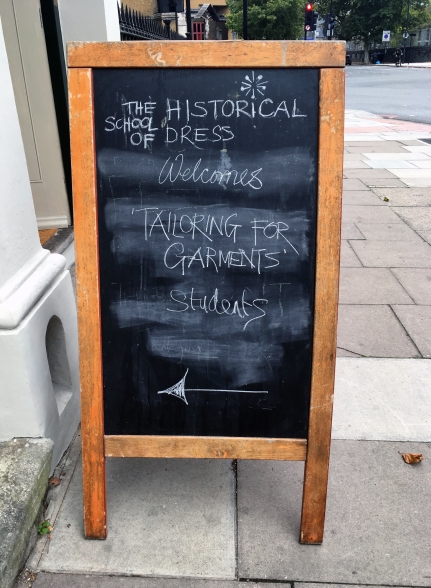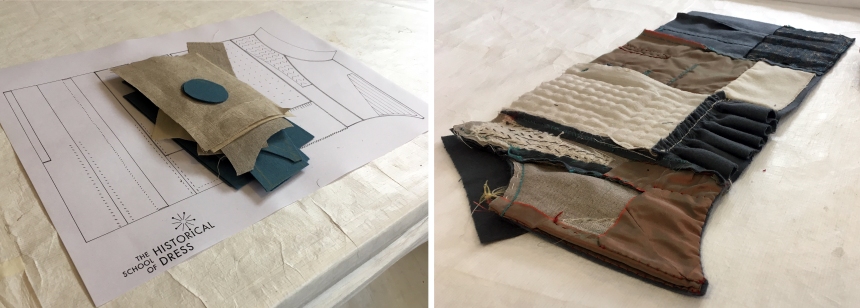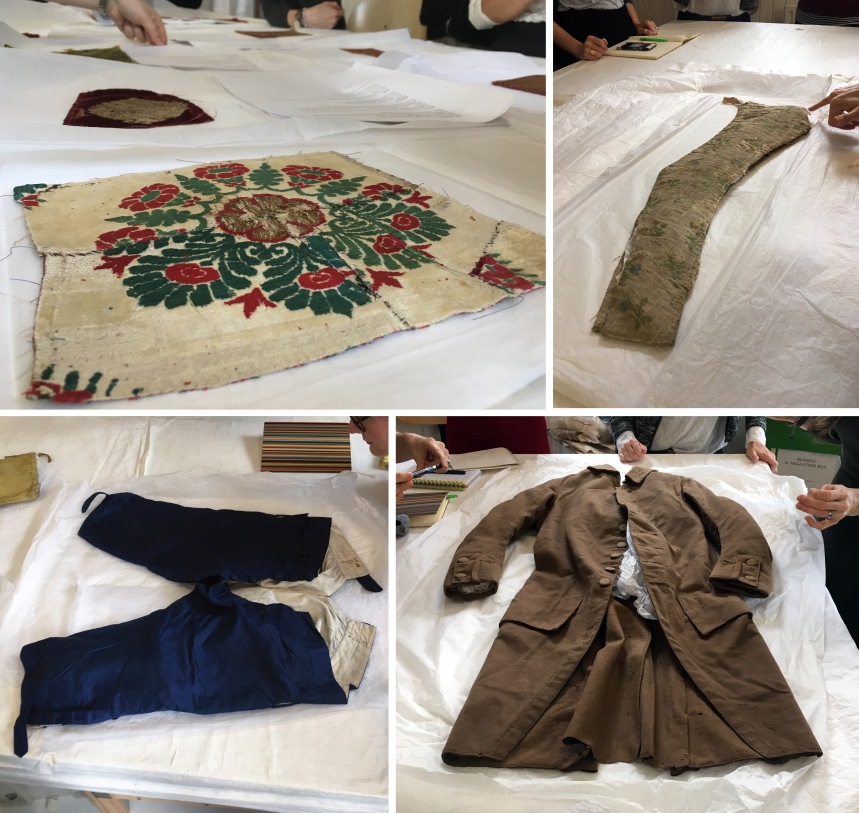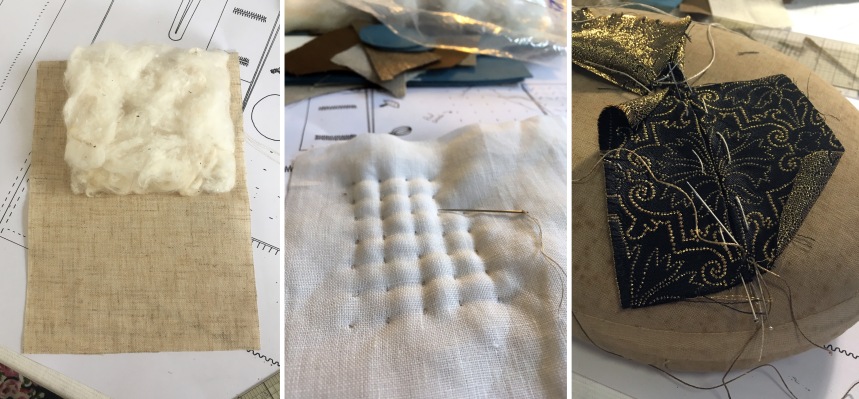The second year of my PhD has kicked off in style.
Last weekend, I was lucky enough to attend a short course at The School of Historical Dress in London.
The School of Historical Dress was founded by Jenny Tiramani (formerly Director of Theatre Design at Shakespeare’s Globe Theatre, 1997-2005), Santina Levey, and Vanessa Hopkins in 2011 to promote the study of historical clothing and dressmaking. As well as offering a variety of short courses each year, the School cares for numerous surviving garments and textiles and regularly publishes books about the cut and construction of historical dress.

The course I attended – Tailoring in Garments 1400 – 1800 – was all about historical tailoring practices. Taught by Melanie Braun and Claire Thornton, the three-day course was an intensive, hands-on insight into a range of techniques found in surviving garments and sources from across the centuries. The idea was to turn a neatly-stacked pile of fabric pieces into a fully-formed sampler (i.e. an item created purely to practice/demonstrate technique) using historically-accurate materials and tools. By the end of the course, we’d have learned all of the skills required for us to do this.

Day 1
The course began with an introduction to the history of tailoring. With reference to various historical sources (drawings, descriptions, and facsimiles of early printed books), Melanie and Claire explained how practices evolved from the advent of the trade (in Europe) in the 13th century through to the turn of the 19th century. This all came to life as we looked at examples of surviving textiles and garments, including an early-17th-century sleeve made of cloth of silver, a mid-17th-century velvet bodice, a pair of early-18th-century breeches, and a late-18th-century coat. It was brilliant to be able to look at these items so closely: construction details are often hidden when historical garments are displayed in books or exhibitions; I was able to learn a lot about how these clothes and textiles were made and worn just by being shown the seams, fastenings, and linings.

After lunch, we got stuck into the more practical parts of the course. We learned several techniques for hand-sewing simple seams, and about how multiple fabric shapes can be pieced together to form larger shapes. Fabric was extremely expensive in past centuries, and so tailors had to be economical when cutting out shapes for garments. As a result, seams can often be found in unexpected places on historical items of clothing, and it’s common for patterned fabrics to not match up neatly. This was something I’d not previously thought about: to what extent do historical costumes for film and theatre reflect these less-aesthetically-pleasing elements of past cutting and piecing practices?
Day 2
The second day was filled with practical training in historical techniques. We started out with quilting – the process of incorporating a layer of soft padding between layers of fabric for warmth, protection, and/or fashion – before moving on to various stitches used to shape or stiffen fabric. In the afternoon, we got started on a short stretch of pleating. Turning a flat piece of fabric into an evenly-gathered, ruffly seam is extremely satisfying! We also began making a small stiffened piece to be inserted into a flat area of the sampler (resembling the stomach area of a flat-fronted doublet) and worked on a small piece of pattern-matching.

Day 3
The third and final day of the course was even more jam-packed than the previous days as we were all keen to get our samplers finished. We learned three different methods of creating buttons and buttonholes/eyelets (dating from the 14th, 17th, and 18th centuries) and tried out different approaches to lining the sampler. Our final task of the weekend was to finish off and sew together the various parts of the sampler we’d been working on during the course.

As well as being a lot of fun, this course was enormously helpful in developing my understanding of early modern dressmaking practices. My research is all about how 21st-century designers incorporate Elizabethan/Jacobean aesthetics into stage and costume design for Shakespeare, and I now feel much better-equipped to analyse surviving costumes and identify which elements are informed by historical practices.
It was also a real privilege to learn from members of the team that designed and crafted the ‘original practices’ (OP) costumes for Shakespeare’s Globe Theatre between 1997 and 2005. The Globe’s OP approach to design is the focus of the first chapter of my thesis. Taking this course really opened my mind to what OP costume design is all about, and showed me exactly how the theatre’s design team replicated garments and practices for the stage. I’m really excited to start applying these ideas to my research as I get stuck into writing this chapter.
Next month, I’ll be taking a second short course at the School (titled The Nature of Fabrics 1400 – 1800, led by Jenny Tiramani). First, though, I’m off to the US for two weeks to participate in the 2017 Blackfriars Conference and to visit archives in Washington D.C. (The Folger Shakespeare Library) and Chicago (The Motley Collection of Theatre and Costume Design). Exciting times indeed – stay tuned for updates!

My research and my attendance at these courses, archives, and events is generously funded by the Midlands3Cities AHRC Doctoral Training Partnership.
With thanks to The School of Historical Dress for their kind permission to share these images and details.

Reblogged this on non sanz droict.
LikeLike
I was fascinated to read about your experience of the short course at The School of Historical Dress in London last weekend, Ella. It felt like a real diving-into the past, picking up the stitches and design concepts and bringing/sewing them into the present. I think any joining up of the past with the present is helpful. Seeing the image of the sleeve of cloth of silver reminded me of seeing a cloak made of cloth of gold in a monastery museum in Greece some years ago. The specialness/preciousness of those fabrics is something that doesn’t have a current, living presence in our (Western) culture, as far as I know. Or does it? If it doesn’t, how do you understand/think about that lack? h
LikeLike